oil change Acura Integra 2000 Hatchback Owner's Manual
[x] Cancel search | Manufacturer: ACURA, Model Year: 2000, Model line: Integra, Model: Acura Integra 2000Pages: 279, PDF Size: 3.57 MB
Page 52 of 279

Carbo
n Monoxid e Hazar d
Your car's exhaust contains carbon monoxide gas. You should have no
problem with carbon monoxide entering the car in normal driving if
you maintain your car properly. Have the exhaust system inspected
for leaks whenever: The car is raised for an oil change.
You notice a change in the sound of the exhaust.
The car was in an accident that may have damaged the underside. High levels of carbon monoxide can
collect rapidly in enclosed areas,such as a garage. Do not run the
engine with the garage door closed.
Even with the door open, run the
engine only long enough to move the
vehicle out of the garage. With the hatch open, air flow can
pull exhaust gas into your car's
interior and create a hazardouscondition. If you must drive with the
hatch open, open all the windows and set the heating and cooling
system as shown below.
If you must sit in your parked car, even in an unconfined area, with the
engine running, adjust the heating
and cooling system as follows:
1. Select the Fresh Air mode.
2. Select the mode.
3. Turn the fan on high speed.
4. Set the temperature control to a
comfortable setting.
Drive
r an d Passenge r Safet y
Carbon monoxide gas is toxic.
Breathing it can cause
unconsciousness and even kill
you.
Avoid any enclosed areas or activities that expose you to
carbon monoxide.
Page 152 of 279
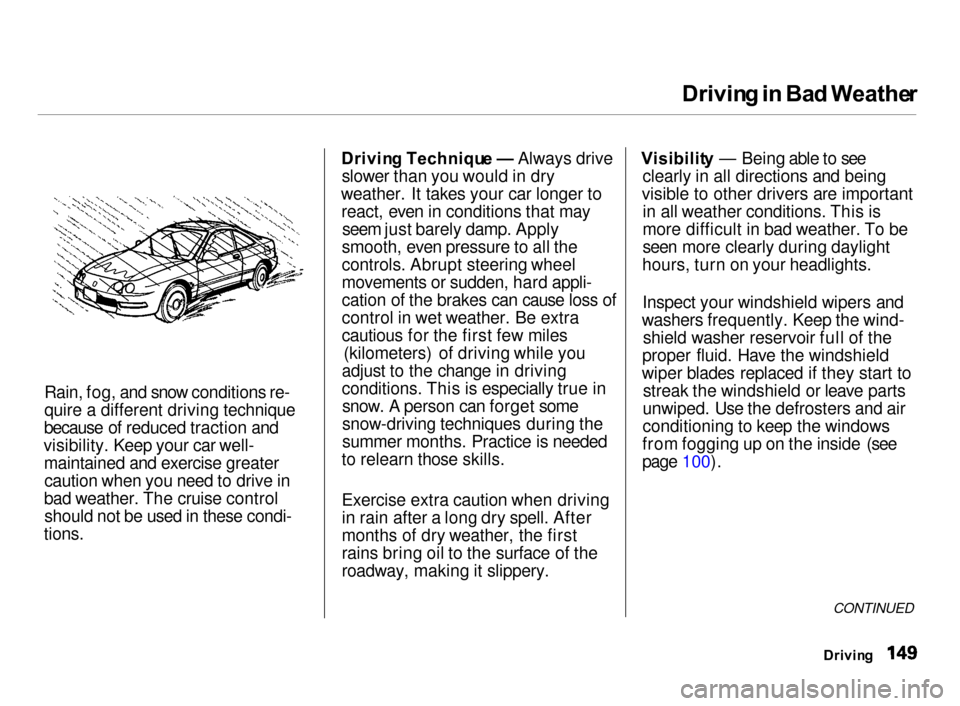
Drivin
g in Ba d Weathe r
Rain, fog, and snow conditions re-
quire a different driving technique
because of reduced traction and
visibility. Keep your car well- maintained and exercise greatercaution when you need to drive in
bad weather. The cruise control should not be used in these condi-
tions.
Drivin
g Techniqu e — Always drive
slower than you would in dry
weather. It takes your car longer to react, even in conditions that may seem just barely damp. Apply
smooth, even pressure to all the
controls. Abrupt steering wheel
movements or sudden, hard appli-
cation of the brakes can cause loss of
control in wet weather. Be extra
cautious for the first few miles (kilometers) of driving while you
adjust to the change in driving
conditions. This is especially true in snow. A person can forget some
snow-driving techniques during the
summer months. Practice is needed
to relearn those skills.
Exercise extra caution when driving
in rain after a long dry spell. After
months of dry weather, the first
rains bring oil to the surface of the
roadway, making it slippery. Visibilit
y — Being able to see
clearly in all directions and being
visible to other drivers are important in all weather conditions. This is
more difficult in bad weather. To be
seen more clearly during daylight
hours, turn on your headlights.
Inspect your windshield wipers and
washers frequently. Keep the wind- shield washer reservoir full of the
proper fluid. Have the windshield
wiper blades replaced if they start to streak the windshield or leave parts
unwiped. Use the defrosters and air
conditioning to keep the windows
from fogging up on the inside (see
page 100).
CONTINUED
Drivin g
Page 176 of 279
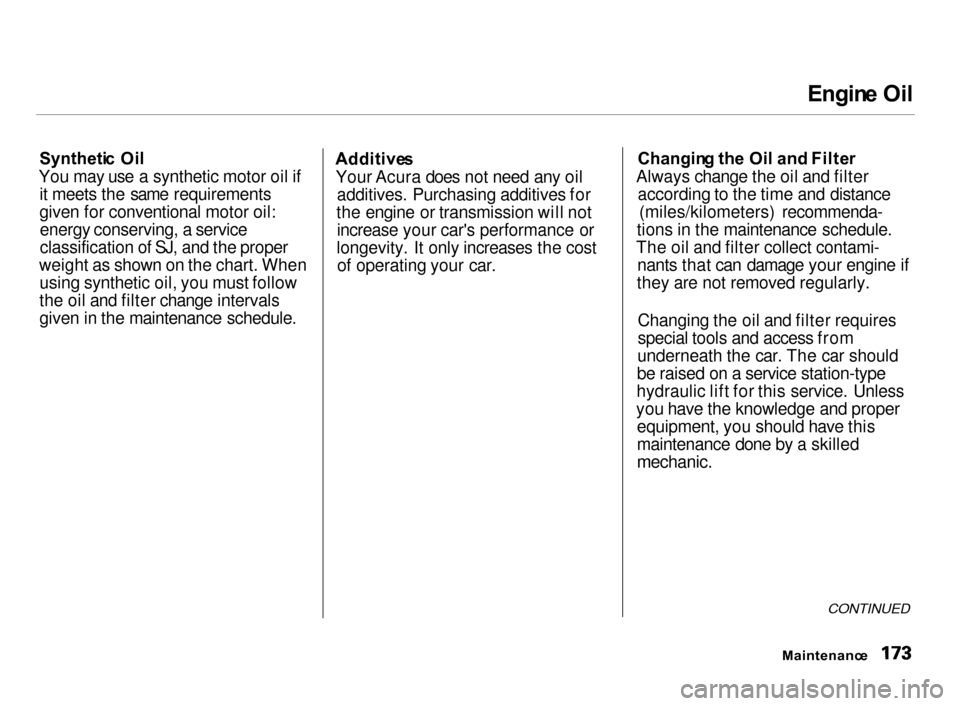
Engin
e Oi l
Syntheti c Oi l
You may use a synthetic motor oil if it meets the same requirements
given for conventional motor oil:energy conserving, a service
classification of SJ, and the proper
weight as shown on the chart. When using synthetic oil, you must follow
the oil and filter change intervals
given in the maintenance schedule. Additive
s
Your Acura does not need any oil additives. Purchasing additives for
the engine or transmission will not increase your car's performance or
longevity. It only increases the cost of operating your car. Changin
g th e Oi l and Filte r
Always change the oil and filter according to the time and distance(miles/kilometers) recommenda-
tions in the maintenance schedule.
The oil and filter collect contami- nants that can damage your engine if
they are not removed regularly.
Changing the oil and filter requires
special tools and access from
underneath the car. The car should
be raised on a service station-type
hydraulic lift for this service. Unless
you have the knowledge and proper equipment, you should have this
maintenance done by a skilled
mechanic.
CONTINUED
Maintenanc e
Page 178 of 279
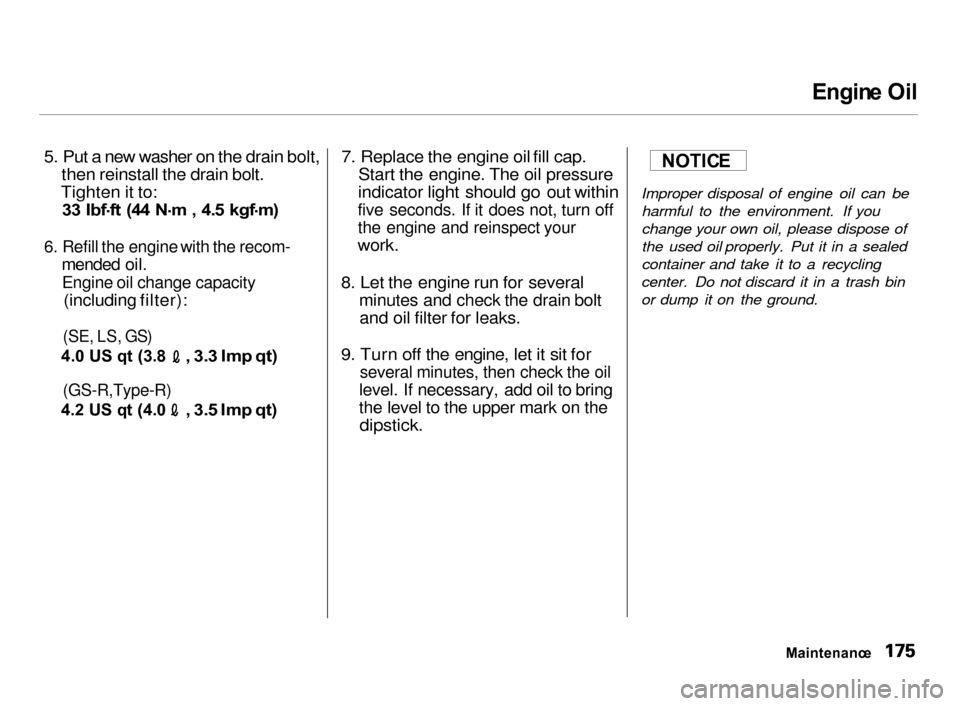
Engin
e Oi l
5. Put a new washer on the drain bolt,
then reinstall the drain bolt.
Tighten it to: 3 3 Ibf .
f t (4 4 N .
m , 4. 5 kgf .
m )
6. Refill the engine with the recom-
mended oil.
Engine oil change capacity
(including filter):
(SE, LS, GS)
4.
0 U S q t (3. 8
, 3.3 Im p qt )
(GS-R,Type-R)
4.
2 U S q t (4. 0
, 3.5 Im p qt ) 7. Replace the engine oil fill cap.
Start the engine. The oil pressure
indicator light should go out within
five seconds. If it does not, turn off
the engine and reinspect your
work.
8. Let the engine run for several
minutes and check the drain bolt
and oil filter for leaks.
9. Turn off the engine, let it sit for
several minutes, then check the oil
level. If necessary, add oil to bring
the level to the upper mark on the
dipstick.
Improper disposal of engine oil can be harmful to the environment. If you
change your own oil, please dispose of
the used oil properly. Put it in a sealed
container and take it to a recycling
center. Do not discard it in a trash bin
or dump it on the ground.
Maintenance
NOTIC
E
Page 210 of 279
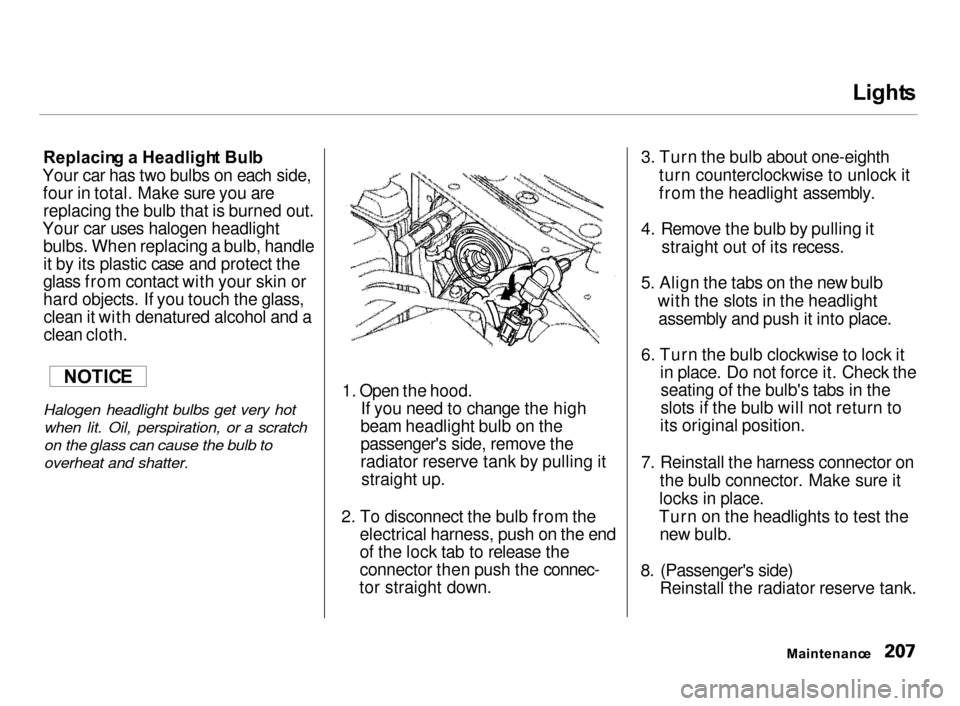
Light
s
Replacin g a Headligh t Bul b
Your car has two bulbs on each side, four in total. Make sure you arereplacing the bulb that is burned out.
Your car uses halogen headlight bulbs. When replacing a bulb, handle
it by its plastic case and protect the
glass from contact with your skin or
hard objects. If you touch the glass,clean it with denatured alcohol and a
clean cloth.
Halogen headlight bulbs get very hot when lit. Oil, perspiration, or a scratch
on the glass can cause the bulb to
overheat and shatter.
1. Open the hood.
If you need to change the high
beam headlight bulb on the
passenger's side, remove the
radiator reserve tank by pulling it straight up.
2. To disconnect the bulb from the
electrical harness, push on the end
of the lock tab to release the
connector then push the connec-
tor straight down.
3. Turn the bulb about one-eighth
turn counterclockwise to unlock it
from the headlight assembly.
4. Remove the bulb by pulling it
straight out of its recess.
5. Align the tabs on the new bulb
with the slots in the headlightassembly and push it into place.
6. Turn the bulb clockwise to lock it
in place. Do not force it. Check the seating of the bulb's tabs in the
slots if the bulb will not return to
its original position.
7. Reinstall the harness connector on
the bulb connector. Make sure it
locks in place.
Turn on the headlights to test the new bulb.
8. (Passenger's side)
Reinstall the radiator reserve tank.
Maintenanc e
NOTIC
E
Page 217 of 279
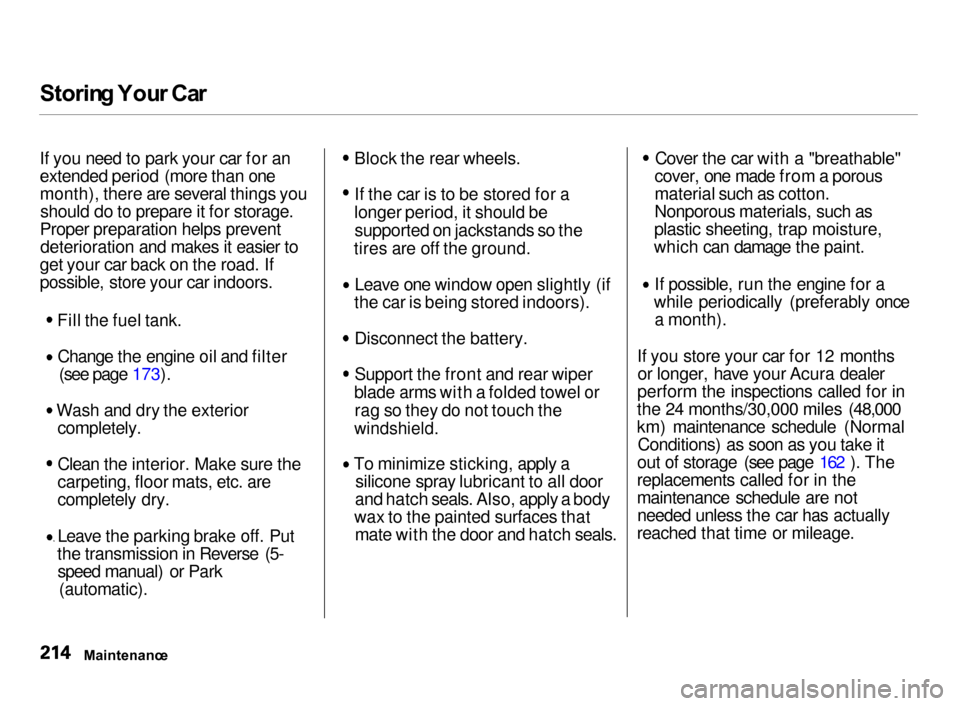
Storin
g You r Ca r
If you need to park your car for an
extended period (more than one
month), there are several things you should do to prepare it for storage.
Proper preparation helps prevent deterioration and makes it easier to
get your car back on the road. If
possible, store your car indoors.
Fill the fuel tank.Change the engine oil and filter (see page 173). Wash and dry the exterior
completely.
Clean the interior. Make sure the
carpeting, floor mats, etc. are
completely dry.
Leave the parking brake off. Put
the transmission in Reverse (5- speed manual) or Park (automatic). Block the rear wheels.
If the car is to be stored for a
longer period, it should be supported on jackstands so the
tires are off the ground. Leave one window open slightly (if
the car is being stored indoors). Disconnect the battery.
Support the front and rear wiper
blade arms with a folded towel or rag so they do not touch the
windshield.
To minimize sticking, apply a
silicone spray lubricant to all door
and hatch seals. Also, apply a body
wax to the painted surfaces that mate with the door and hatch seals. Cover the car with a "breathable"
cover, one made from a porous
material such as cotton.
Nonporous materials, such as
plastic sheeting, trap moisture,
which can damage the paint. If possible, run the engine for a
while periodically (preferably once a month).
If you store your car for 12 months or longer, have your Acura dealer
perform the inspections called for in
the 24 months/30,000 miles (48,000
km) maintenance schedule (Normal Conditions) as soon as you take it
out of storage (see page 162 ). The
replacements called for in the
maintenance schedule are not needed unless the car has actually
reached that time or mileage.
Maintenanc e
Page 271 of 279
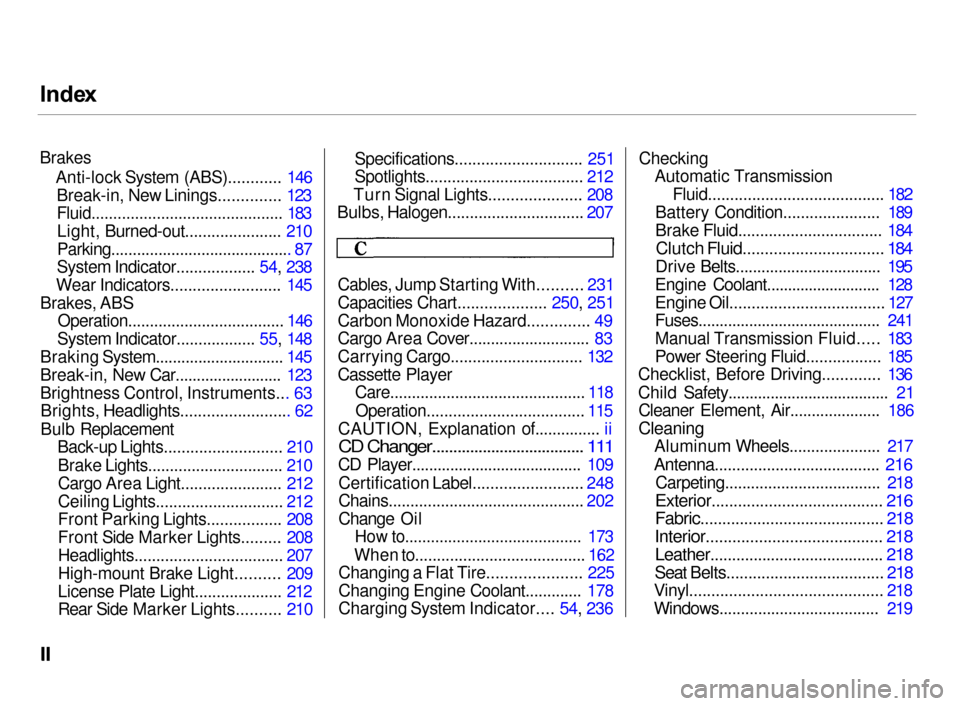
Inde
x
Brakes Anti-lock System (ABS)............ 146Break-in, New Linings.............. 123
Fluid............................................ 183
Light, Burned-out...................... 210
Parking.......................................... 87
System Indicator.................. 54, 238
Wear Indicators......................... 145
Brakes, ABS Operation.................................... 146
System Indicator.................. 55, 148
Braking System.............................. 145
Break-in, New Car......................... 123
Brightness Control, Instruments... 63 Brights, Headlights......................... 62
Bulb Replacement Back-up Lights........................... 210
Brake Lights............................... 210
Cargo Area Light....................... 212
Ceiling Lights............................. 212
Front Parking Lights................. 208
Front Side Marker Lights......... 208
Headlights.................................. 207
High-mount Brake Light.......... 209
License Plate Light.................... 212
Rear Side Marker Lights.......... 210 Specifications............................. 251
Spotlights.................................... 212
Turn Signal Lights..................... 208
Bulbs, Halogen............................... 207
Cables, Jump Starting With.......... 231
Capacities Chart.................... 250, 251
Carbon Monoxide Hazard.............. 49
Cargo Area Cover............................ 83
Carrying Cargo.............................. 132
Cassette Player Care............................................. 118
Operation.................................... 115
CAUTION, Explanation of............... ii
CD Changer.................................... 111
CD Player........................................ 109
Certification Label......................... 248
Chains............................................. 202
Change Oil
How to......................................... 173
When to....................................... 162
Changing a Flat Tire..................... 225
Changing Engine Coolant............. 178
Charging System Indicator.... 54, 236 Checking
Automatic Transmission
Fluid........................................ 182
Battery Condition...................... 189
Brake Fluid................................. 184
Clutch Fluid................................ 184
Drive Belts.................................. 195
Engine Coolant........................... 128
Engine Oil................................... 127
Fuses........................................... 241
Manual Transmission Fluid..... 183
Power Steering Fluid................. 185
Checklist, Before Driving............. 136
Child Safety...................................... 21 Cleaner Element, Air..................... 186
Cleaning
Aluminum Wheels..................... 217
Antenna...................................... 216
Carpeting.................................... 218
Exterior....................................... 216
Fabric.......................................... 218
Interior........................................ 218
Leather........................................ 218
Seat Belts.................................... 218
Vinyl............................................ 218
Windows..................................... 219
Page 275 of 279
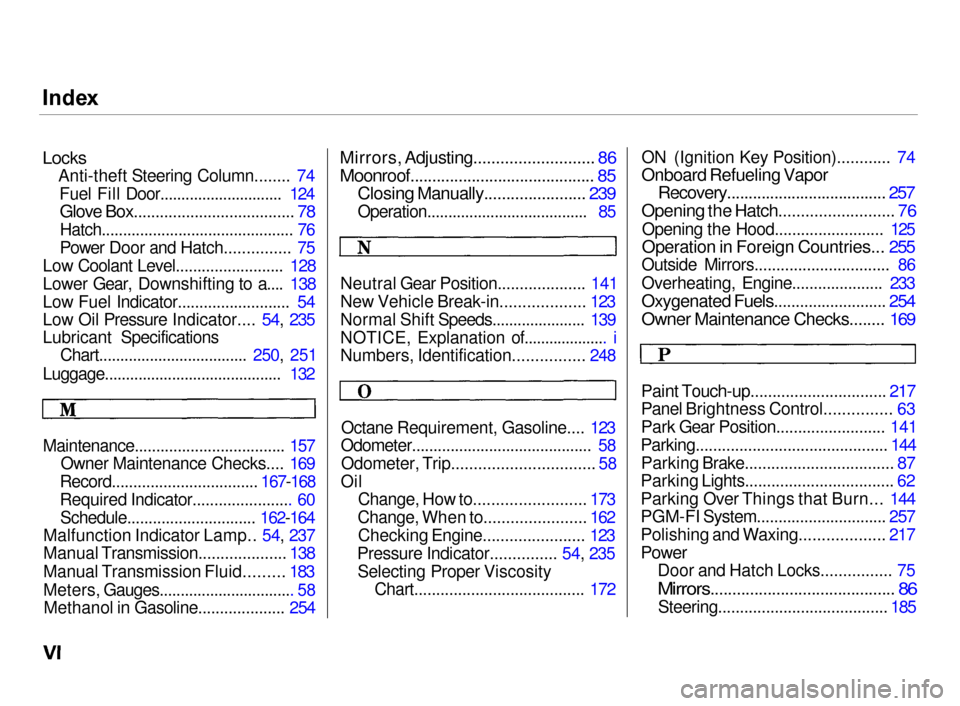
Inde
x
Locks
Anti-theft Steering Column........ 74
Fuel Fill Door............................. 124
Glove Box..................................... 78
Hatch............................................. 76
Power Door and Hatch............... 75
Low Coolant Level......................... 128
Lower Gear, Downshifting to a.... 138
Low Fuel Indicator.......................... 54
Low Oil Pressure Indicator.... 54, 235
Lubricant Specifications Chart................................... 250, 251
Luggage.......................................... 132
Mirrors, Adjusting........................... 86
Moonroof.......................................... 85
Closing Manually....................... 239
Operation...................................... 85
Neutral Gear Position.................... 141
New Vehicle Break-in................... 123
Normal Shift Speeds...................... 139
NOTICE, Explanation of.................... i
Numbers, Identification................ 248
Octane Requirement, Gasoline.... 123
Odometer.......................................... 58
Odometer, Trip................................ 58
Oil
Change, How to......................... 173
Change, When to....................... 162
Checking Engine....................... 123
Pressure Indicator............... 54, 235 Selecting Proper Viscosity Chart....................................... 172 ON (Ignition Key Position)............ 74
Onboard Refueling Vapor
Recovery..................................... 257
Opening the Hatch.......................... 76
Opening the Hood......................... 125
Operation in Foreign Countries... 255
Outside Mirrors............................... 86
Overheating, Engine..................... 233
Oxygenated Fuels.......................... 254
Owner Maintenance Checks........ 169
Paint Touch-up............................... 217
Panel Brightness Control............... 63
Park Gear Position......................... 141
Parking............................................ 144 Parking Brake.................................. 87
Parking Lights.................................. 62
Parking Over Things that Burn... 144
PGM-FI System.............................. 257
Polishing and Waxing................... 217
Power
Door and Hatch Locks................ 75
Mirrors.......................................... 86
Steering....................................... 185
Maintenance................................... 157
Owner Maintenance Checks.... 169
Record.................................. 167-168
Required Indicator....................... 60 Schedule.............................. 162-164
Malfunction Indicator Lamp.. 54, 237
Manual Transmission.................... 138
Manual Transmission Fluid......... 183
Meters, Gauges................................ 58 Methanol in Gasoline.................... 254
Page 277 of 279
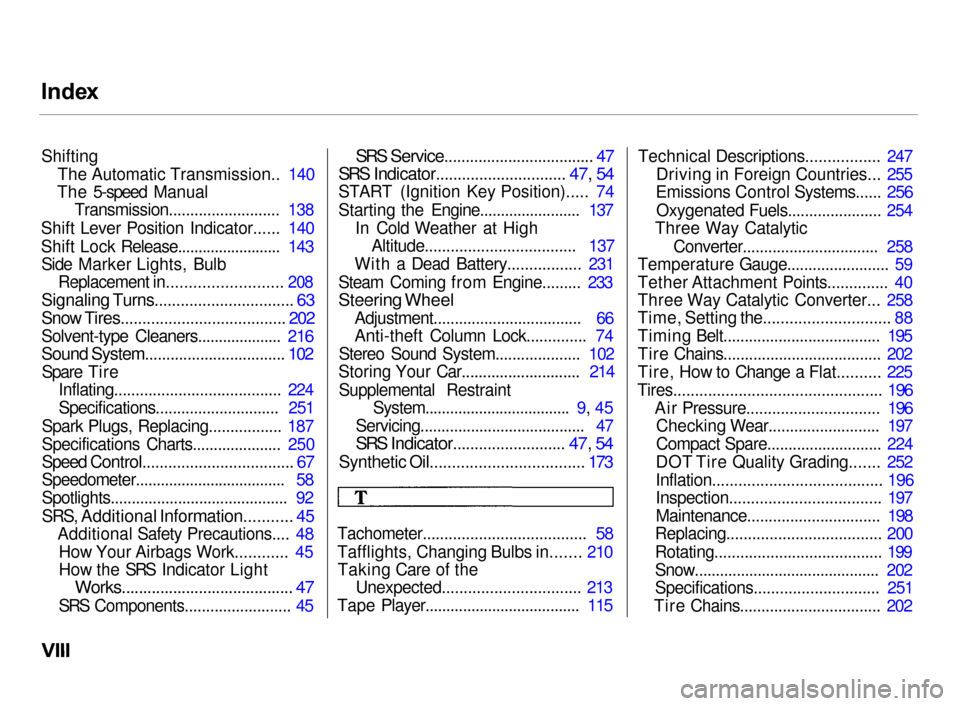
Inde
x
Shifting The Automatic Transmission.. 140
The 5-speed Manual Transmission.......................... 138
Shift Lever Position Indicator...... 140
Shift Lock Release......................... 143 Side Marker Lights, Bulb
Replacement in.......................... 208
Signaling Turns................................ 63
Snow Tires...................................... 202
Solvent-type Cleaners.................... 216
Sound System................................. 102
Spare Tire Inflating....................................... 224
Specifications............................. 251
Spark Plugs, Replacing................. 187
Specifications Charts..................... 250
Speed Control................................... 67
Speedometer.................................... 58
Spotlights.......................................... 92
SRS, Additional Information........... 45
Additional Safety Precautions.... 48
How Your Airbags Work............ 45
How the SRS Indicator Light
Works........................................ 47
SRS Components......................... 45
SRS Service................................... 47
SRS Indicator.............................. 47, 54
START (Ignition Key Position)..... 74
Starting the Engine........................ 137
In Cold Weather at HighAltitude................................... 137
With a Dead Battery................. 231
Steam Coming from Engine......... 233
Steering Wheel
Adjustment................................... 66
Anti-theft Column Lock.............. 74
Stereo Sound System.................... 102
Storing Your Car............................ 214
Supplemental Restraint System...................................
9, 45
Servicing....................................... 47
SRS Indicator.......................... 47, 54
Synthetic Oil................................... 173
Tachometer...................................... 58
Tafflights, Changing Bulbs in....... 210 Taking Care of the Unexpected................................ 213
Tape Player..................................... 115 Technical Descriptions................. 247
Driving in Foreign Countries... 255
Emissions Control Systems...... 256
Oxygenated Fuels...................... 254
Three Way Catalytic
Converter................................ 258
Temperature Gauge........................ 59
Tether Attachment Points.............. 40
Three Way Catalytic Converter... 258
Time, Setting the............................. 88
Timing Belt..................................... 195
Tire Chains..................................... 202
Tire, How to Change a Flat.......... 225
Tires................................................ 196 Air Pressure............................... 196Checking Wear.......................... 197
Compact Spare........................... 224
DOT Tire Quality Grading....... 252
Inflation....................................... 196
Inspection................................... 197
Maintenance............................... 198
Replacing.................................... 200
Rotating....................................... 199
Snow............................................ 202
Specifications............................. 251
Tire Chains................................. 202
Page 279 of 279
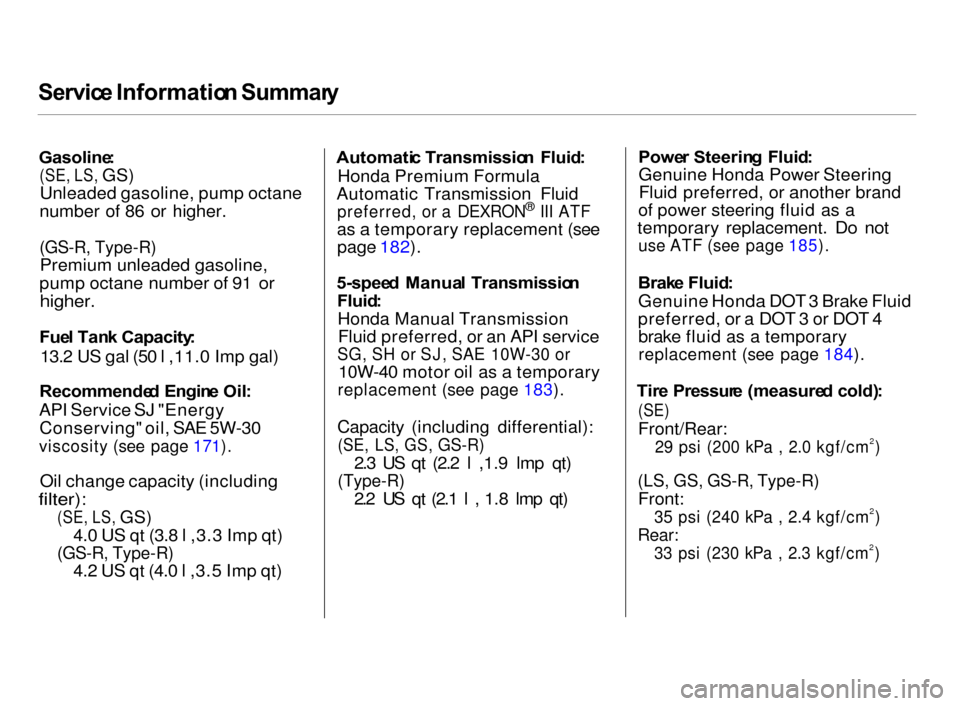
Servic
e Informatio n Summar y
Gasoline :
(SE,
LS,
GS) Unleaded gasoline, pump octane
number of 86 or higher.
(GS-R, Type-R)
Premium unleaded gasoline,
pump octane number of 91 or
higher.
Fue l Tan k Capacity :
13.2 US gal (50 l ,11.0 Imp gal)
Recommende d Engin e Oil :
API Service SJ "Energy Conserving" oil, SAE 5W-30
viscosity (see page 171).
Oil change capacity (including
filter):
(SE,
LS,
GS)4.0 US qt (3.8 l ,3.3 Imp qt)
(GS-R, Type-R)
4.2 US qt (4.0 l ,3.5 Imp qt) Automati
c Transmissio n Fluid :
Honda Premium Formula
Automatic Transmission Fluid
preferred, or a DEXRON ®
III ATF
as a temporary replacement (see page 182).
5-spee d Manua l Transmissio n
Fluid :
Honda Manual Transmission Fluid preferred, or an API service
SG, SH or SJ, SAE 10W-30 or
10W-40 motor oil as a temporary
replacement (see page 183).
Capacity (including differential):
(SE,
LS,
GS,
GS-R)
2.3 US qt (2.2 l ,1.9 lmp qt)
(Type-R)
2.2 US qt (2.1 l , 1.8 lmp qt) Powe
r Steerin g Fluid :
Genuine Honda Power Steering Fluid preferred, or another brand
of power steering fluid as a
temporary replacement. Do not
use ATF (see page 185).
Brak e Fluid :
Genuine Honda DOT 3 Brake Fluid
preferred, or a DOT 3 or DOT 4 brake fluid as a temporary
replacement (see page 184).
Tir e Pressur e (measure d cold) :
(SE)
Front/Rear:
29 psi (200 kPa , 2.0 kgf/cm2)
(LS, GS, GS-R, Type-R)
Front:
35 psi (240 kPa , 2.4 kgf/cm2)
Rear:
33 psi (230 kPa , 2.3 kgf/cm2)